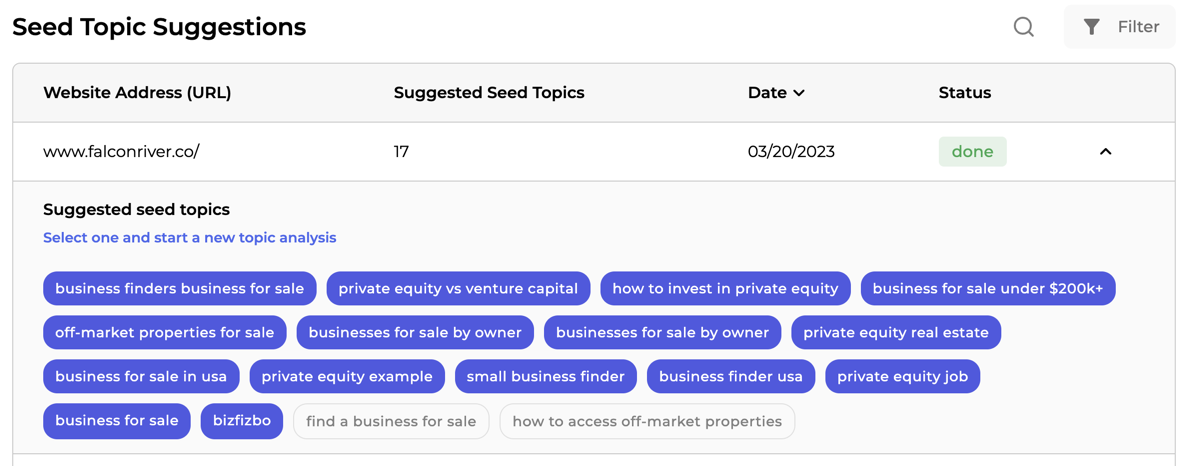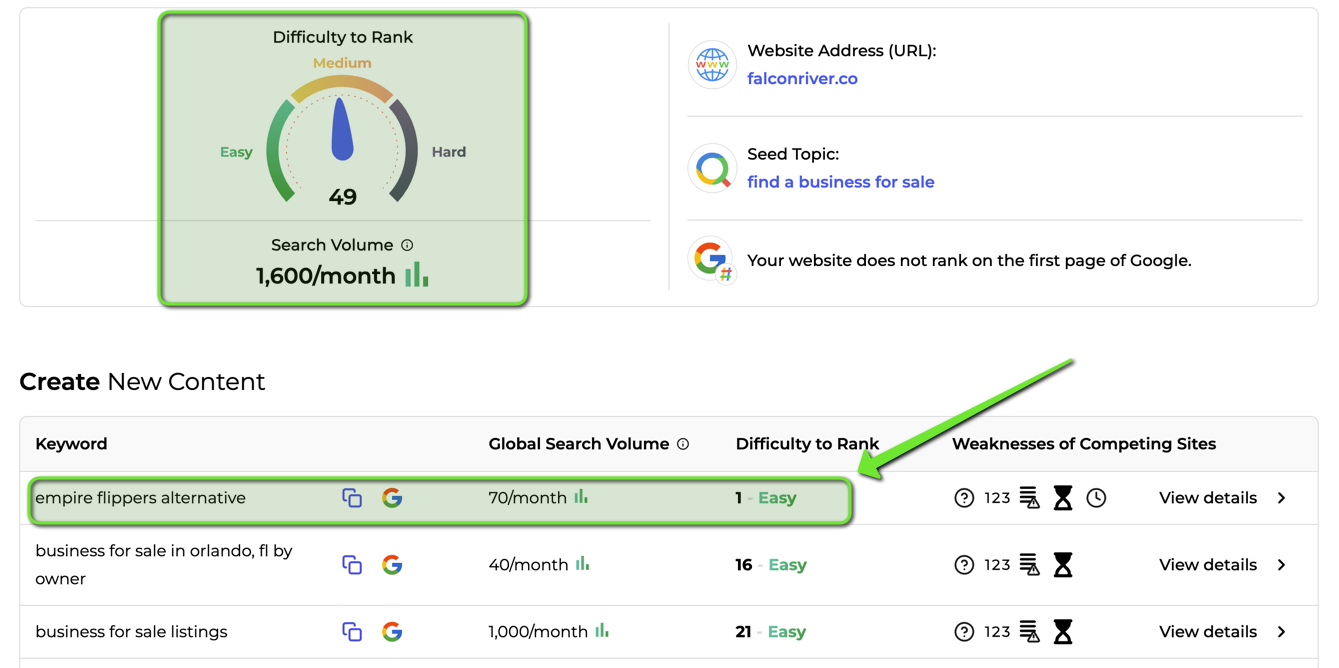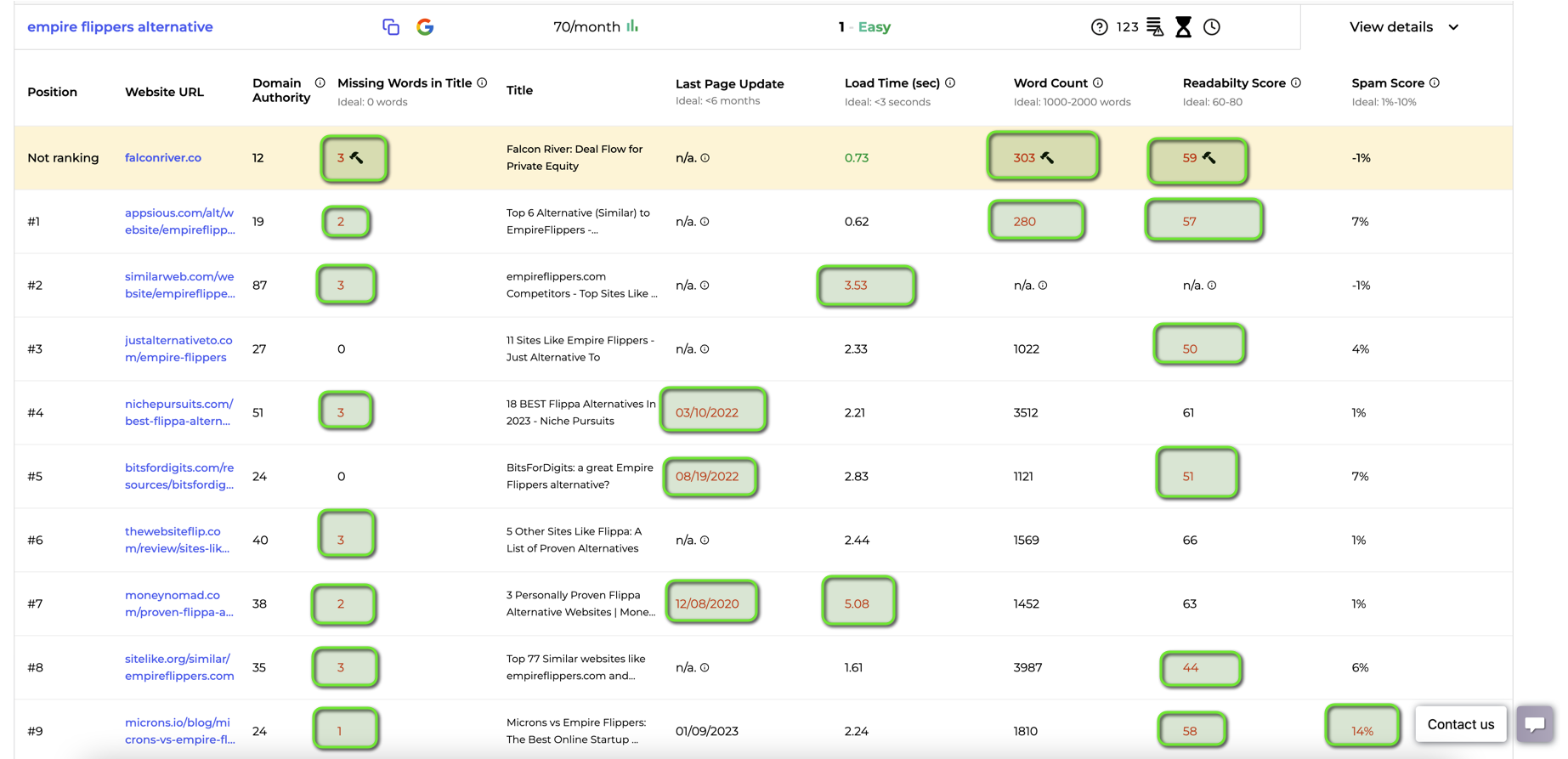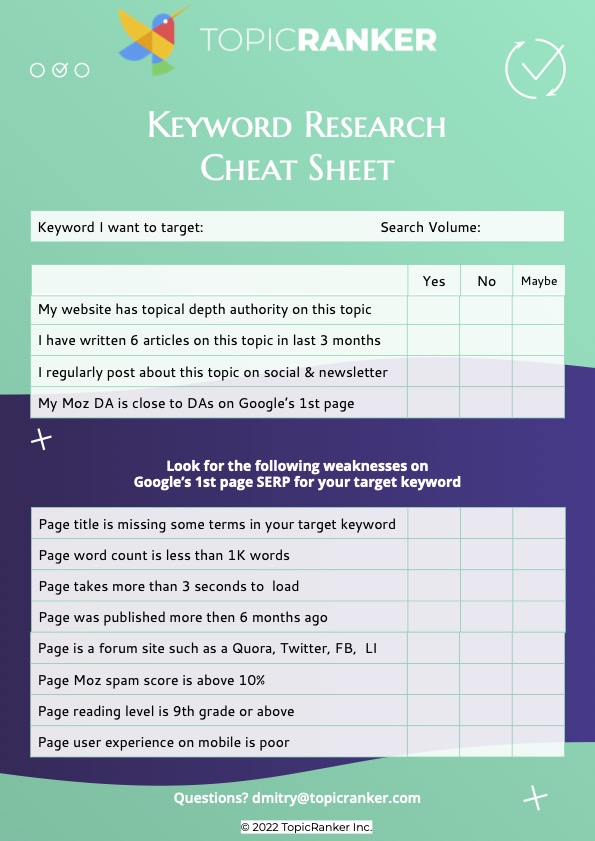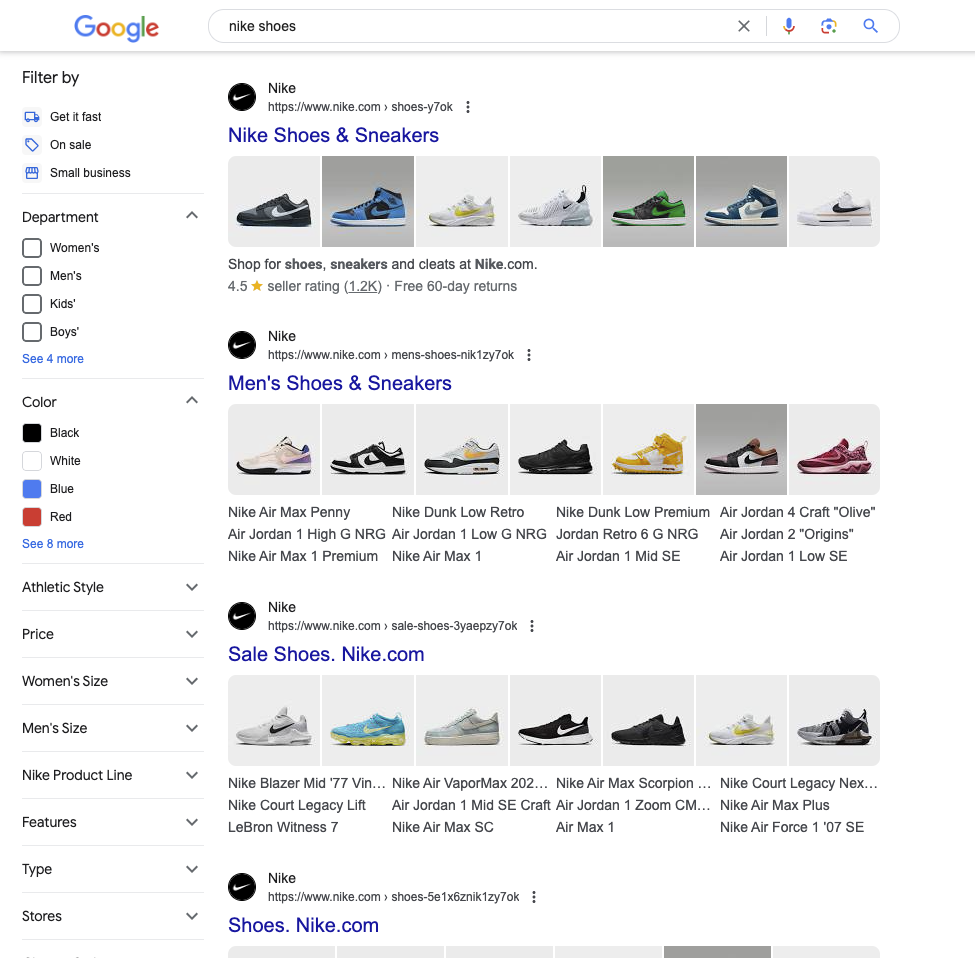There is one clear lesson we can learn from Google Search Team post on Google Search Console blog about the latest algorithm update of August 2024:
Google wants everyone to make their content as useful and helpful and humanely possible.
The search team has explicitly said that performing SERP analysis and finding real problems and issues on SERP to find an SEO target keyword is what everyone should be doing. Here are some of the problems you should look for on SERP to qualify it as a good one for you to go after:
- Low authority & backlinks sites ranking in top 10 spots
- Title mismatch – the search query googled does not match the title in top 10 results that are ranking
- Outdated content
- Thin content – content ranking in top 10 is less than 800 words in length
- Poor load score on mobile for top 10 ranking – takes more than 3 seconds to load
- Poor readability for top 10 ranking
- High spam score of the domain ranking in top 10 and other
Here’s a real life case study example: Right after I created the brand new domain TopicRanker.com, I decided I wanted to make it rank on Google in two weeks. I found the keyword term “which keywords are best to target” and noticed it had several problems in the SERP:
- All the top 10 search results didn’t have the exact search term I googled in its title
- Page load time of top 3 results on the SERP was above 3 seconds
- Pages ranking #2 and #4 had only 800 words in the article – thin content!
- Pages ranking #5 and #6 had poor readability score and poor UX
The term “which keywords are best to target” had a decent search volume of 390/month and was topically relevant to my business. That was enough for me to qualify the keyword as one to go after.
I wrote my article targeting the weaknesses above and it was ranking #1 within a week – all without any backlinks!!!!
Here’s the full case study: How To Find Which Keywords Are Best To Target (2024 Update)
This is the same exact process I used to start and scaled 3 startups from scratch to acquisition by Semrush in 2023, by Google in 2014, by early employees of Slack in 2024. Case studies here.
In this article, I’m going to walk you through the biggest differences in my approach compared to most businesses when it comes to finding SEO target keywords.
Ready? Let’s dive in!
5 Steps to Choose the Right SEO Target Keywords
1. Perform keyword research
First, forget everything you think you know about typical keyword research. These are the ONLY two factors you need to focus on at first:
- Search volume of the keyword
- Is there an actual problem on the current SERP for the keyword? If there are no issues – forget ALL other factors. Go back to the drawing board.
The biggest difference in my approach to keyword research is that I only pick keywords that are low hanging fruit – meaning I know exactly what is wrong on the SERP and what I can do to address to issue.
Here is a quick video walk through of how I pinpoint the exact keywords with problems on SERP:
Once I’ve found a keyword with a major issue (or multiple) in the first page of the SERP results, I’ll consider these other factors (but never before):
- Search volume of the keyword
- Average clickthrough rate and traffic estimate
- Topical relevance
- Competition metric
- Authority of other competitors ranking in the top 10 results
Now, there are a few ways you can go about actually uncovering these keywords. You can input a seed topic related to your business into your keyword research tool of choice and then go through and manually evaluate the SERP results of each term it returns. From there, make a list of the keywords which have weakness signals in the search results.
The problem: Finding these weak SERPs can be VERY manual and labor intensive. I built TopicRanker to make it easy to scale this process and take a lot of work out of it.
Just input your URL and our algorithm will parse your site in order to understand its niche and topical relevance. Then it’ll uncover multiple seed topics to use as a starting point in your keyword research.
You can then select any given seed topic. TopicRanker will show you keyword suggestions that the algorithm believes your site can rank for easily based on specific issues on search results which it highlights:
TopicRanker’s suggestions are based on problem SERPs and your domain specifically, meaning two things:
- Less generic keyword suggestions
- Less manual SERP analysis
Key Takeaway: Study your niche and industry to come up with seed topics that you can then input into a keyword research tool, or just use TopicRanker which takes a lot of the manual labor out of it.
2. Evaluate keyword difficulty and ranking potential
SEO tools like Ahrefs display the monthly search volume as well as a difficulty score for keywords, which can give you a baseline idea of how difficult it may be to rank.
But these scores shouldn’t be taken as gospel. You still need to manually evaluate the SERP to find weaknesses. These indicate an opportunity to outrank your competitors if you capitalize on those in your own content.
This is where a lot of marketers go wrong. They use a tool to grab a bunch of long tail keywords that have low difficulty scores but don’t actually check to see if there are issues that can be addressed.
As I mentioned earlier, weakness signals are the most important qualifier when determining whether a keyword has ranking potential.
These are some specific weakness signals you should be looking for in the SERP:
- Titles missing some terms in the target keyword
- Pages that have less than 1000 words
- Pages that take more than 3 seconds to load
- Publish dates from more than 6 months ago
- Reading level above the 9th grade
- Poor mobile user experience
TopicRanker lays out the top 10 search results and highlights the weaknesses in each:
We also have a checklist you can use if you’re manually evaluating the SERP:
Key Takeaway: Keyword difficulty “scores” are often arbitrary – instead, look for weak spots in the SERP results to capitalize on in your content.
3. Utilize long tail keywords
Long tail keywords typically have much lower search volume, but they can actually be more valuable.
This is especially true if your website is smaller.
Small sites usually don’t have the domain authority needed to rank for high volume keywords, so drilling down into super specific long tail queries that are less competitive can make it easier to rank.
For example, let’s say you’re a flower company. It might make sense to target a keyword like “wedding bouquets” if that’s a product you offer. But that’s a pretty broad keyword with tons of competition. Unless you have a super high domain authority already, you’re not likely to rank for it.
Instead, target long tail queries that are much more specific, such as “rustic pink wedding bouquets” – way less search volume here, but also way less competition.
That isn’t to say that you should go after terms with less than 50 searches per month – ideally, you want a search volume of at least 50 to 100.
Key Takeaway: You’ll have a much better chance of gaining a foothold in the search results when you target long tail keywords over short tail keywords – especially if your website is brand new.
4. Target local keywords
If you serve customers from a physical location, you absolutely need to be targeting local SEO keywords.
These are essentially just keywords that contain location-specific phrases. For example, I’m sure you’ve probably at some point searched “plumbers near me” or something similar.
Start by brainstorming a simple list of words and phrases that people might use when searching for your services. Let’s say you’re a plumbing business. Some of those search terms might be:
- Plumber
- Plumbing services
- Leaky faucet repair
- Sink installer
- Sewage pipe installation
Anything related to your product or service and the pain points your customer is experiencing are good starting points here.
Then, add your location terms. For this example, we’ll pretend you’re located in Denver, Colorado. You’d end up with something like:
- Plumber near me
- Plumbing services nearby
- Local leaky faucet repair
- Sink installer near Colorado Springs
- Sewage pipe installation in Denver
Once you have a list of potential keywords, you’ll still need to manually analyze search intent and check for competitor weaknesses, but you get the overall point.
Key Takeaway: Local keywords drive people in your geographic area to your business, and there’s usually much less competition for these terms.
5. Identity high-value keywords
This is the part of the process where you sit down and decide which keywords are high-value and which ones you want to target first.
Now, this largely comes down to your personal business goals, but there are a few common signals that a keyword is high-value:
- High traffic potential
- High cost per click (CPC)
- Potential for backlinks
- Low ranking difficulty
While these are all important metrics to consider, you really need to think about how a given keyword ties into your offering.
Will ranking for it help increase sales or bring in new customers? How will it bring value to your business? If you can’t answer these questions, the keyword probably isn’t high-value.
Key Takeaway: Just because a keyword seems high-value on the surface doesn’t always mean it makes sense for your business to target.
Where to Implement SEO Target Keywords
You want to weave your keyword naturally throughout your on-page content. That said, be careful not to go overboard as this can actually end up hurting your rankings in the long run. And remember that it’s okay to use variations of the keyword that sound more natural rather than forcing in the exact phrase (which hurts your content’s readability).
Aside from the body of your page or article, these are some other places where it makes sense to include your target keyword:
- Meta descriptions: Meta descriptions aren’t direct ranking factors, but they can help Google determine the relevance of your content in relation to what users are searching for.
-
- URLs: Your keyword should be in your slug, ideally at the front. For example, https://yoursite.com/target-keyword.
- Titles and headings: It’s best practice to include your target keyword in your page title as well as in a couple subheadings if possible.
- Image alt text: Write descriptive alt text for images in your article that include the target keyword in some form.
- Link anchor text: Internally linking between your content helps Google better understand what your site is all about. It’s even better if the anchor text is optimized. If you have multiple links pointing to the same page, you’ll want to slightly vary your anchor text so as not to get slapped with a link penalty.
Common SEO Keyword Mistakes to Avoid
Mistake #1: Keyword stuffing
Keyword stuffing involves “stuffing” as many keywords as possible into your content to increase your chances of ranking.
Not only is this technique unlikely to work, but it could also earn your site a penalty if discovered by Google. Plus, it makes for an absolutely terrible user experience.
So, make sure you don’t:
- Insert random keywords that are irrelevant to the specific page
- Repeat the same keywords over and over in a way that disrupts readability
- Use blocks of SEO target keywords
- Embed “invisible” keywords by changing the font color to white
- Include keywords in the backend of the page via code
Mistake #2: Targeting irrelevant or low-quality keywords
A mistake a lot of business owners make is targeting keywords that are irrelevant to their site, i.e. keywords related to topics that they haven’t written much about on their blog.
When you’ve not written much about a specific topic, you’re a newbie on that topic in Google’s eyes.
In other words, you lack the topical depth authority needed to rank high for the keyword in question.
A general rule of thumb when considering a keyword is to make sure you’ve written at least 6 articles on that same general topic in the last three months on your blog.
The keywords you pursue should also be tied to your revenue in some way. For example, if you’re a sales automation platform, a keyword like “business growth tips” might seem like a good idea, but it’s actually low-quality as it’s unlikely to convert.
However, a keyword like “email automation template” could be tied directly back to the service you’re offering and therefore would convert much better.
Mistake #3: Ignoring search intent
You could write the best article in the world on a topic, but if it doesn’t meet the search intent for the query, it’s not going to rank highly or convert.
There are 4 primary types of search intent:
- Informational (searches to learn about something)
- Navigational (searches to locate a specific website or contact information)
- Transactional (searches to purchase something)
- Commercial (searches to research and buy something in the near future)
A real problem arises when you create an informational piece of content for a transactional keyword, or vice versa.
Take a look at the keyword “nike shoes” for example:
All of the page 1 results are shopping links. You might think an exhaustive piece of content about the history of Nike shoes and how to choose the best pair might be helpful, but it completely ignores the demonstrated search intent.
Don’t waste your valuable time creating content that doesn’t meet search intent.
Mistake #4: Only targeting high-volume keywords
The harsh truth is that unless you’re a major brand, you’re most likely not going to rank on the first page for major keywords with hundreds of thousands of searches per month.
Now, I think there’s something to be said about targeting these keywords for the sake of building topical authority (and ultimately providing value to your audience).
My advice is to be realistic with yourself. If you have a small or brand new website, I wouldn’t focus very much energy at all on high-volume keywords in the beginning. Low-volume keywords are going to be more effective and more worth your time.
Mistake #5: Failing to track and analyze keyword performance
Analyzing keyword performance involves measuring the specific results you’re getting from your efforts. This is usually a combination of:
- Rankings
- Traffic
- Conversions
- Revenue
The bottom line is that if you’re not tracking how your keywords are performing, you’re not going to have any sort of idea of whether or not your content efforts are worthwhile.
If you’re measuring your keyword performance and find that you’re not getting the ROI you want, you can switch things up rather than continue to pour time and money into a strategy that just isn’t working.
Tracking and Analyzing Keyword Performance
We already talked about how not tracking your keyword performance is a massive mistake. Here are a few additional things to keep in mind:
- Utilize keyword tracking tools to analyze your rankings: Many tools out there (Semrush, Ahrefs, Keysearch, etc.) can monitor where you rank on the SERPs for your targeted keywords so you don’t have to keep track manually.
- Monitor keyword performance over time: Don’t panic if one of your ranking pages suddenly drops off out of nowhere. SERP volatility can cause extreme fluctuations (positive or negative) like these. You’ll get a more accurate idea of keyword performance if you analyze weekly or monthly trends rather than day-to-day.
- Adjust your keyword strategy based on data: Don’t switch things up based on a gut feeling. Unless you have tangible data in front of you that shows your current strategy isn’t working, then my motto is: If it ain’t broke, don’t fix it.
- Understand the impact of algorithm updates: Google algorithm updates are happening more and more frequently nowadays. It’s important to stay up-to-date, but at the same time, don’t hastily upheave your entire keyword strategy due to an algorithm update until that update is 100% rolled out.
The Bottom Line on SEO Target Keywords
By now, you should have a deep understanding of SEO target keywords and a good idea of how to choose the right ones that have the best chance of ranking on Google.
But the work doesn’t stop there. If you want to stay on top in a volatile search landscape where Google keeps rolling out one algorithm after another, you need to be constantly evolving your target keyword strategy.
What worked yesterday may not work tomorrow.
If you want a tool that’s going to take the bulk of keyword research off your shoulders, consider trying out TopicRanker. If you subscribe, you’ll also get access to AI-assisted tools for coming up with titles, meta descriptions, and even content briefs and outlines.

Dmitry is the founder of TopicRanker – a software tool to find problems & weaknesses on Google search results and discover keywords you can easily rank for with your website. Over the last 10 years, Dmitry has helped 300+ brands rank #1 on Google through PR and SEO. Dmitry used PR & SEO to grow a startup from 0 to 40 million views per month, and got acquired by Google in 2014. He translated his know-how into JustReachOut.io, a SaaS tool to get covered in press and build authority backlinks without PR firms; it’s been used by 5000+ content marketers to date and was acquired in 2020.


